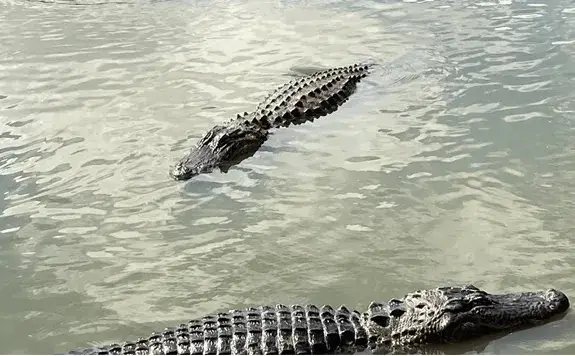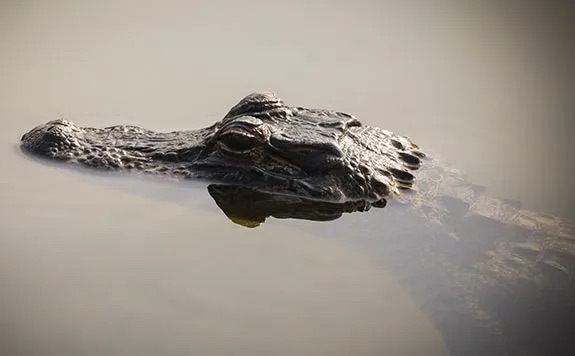This article was sponsored by Circle M Hunts.
Alligator hunting, or as we will refer to it as gator hunting, is unlike any other type of hunt out there.
Taking down a gator combines the thrill of big game hunting with the challenge of fishing, all set in swamps and waterways teeming with excitement, but also danger.
For non-hunters, people just getting into hunting, or even some seasoned ones, hunting gators is an unknown, so we decided to put together a 10,000-foot overview of what hunting gators really looks like.
Where and When Can You Hunt Alligators?
In the United States, gator hunting is permitted in the Southeast, across states from North Carolina down through Florida and west to Texas, plus a few inland states like Arkansas.
The largest gator populations (and most well-known hunts) are in Florida, Louisiana, and Texas, but many neighboring states also have limited gator seasons. These seasons typically run in the late summer, typically August through October, depending on the state. Alligator hunting isn’t a year-round activity, but rather it’s a special seasonal hunt, much like a limited big-game season.
Because alligator populations are closely managed, most states issue a limited number of tags or permits each year. Many states use lottery drawings or special applications in the summer to select which hunters get a tag.
If you’re lucky enough to draw a tag (or buy one in states that sell them), it usually permits you to harvest one or a small number of alligators during the season, so you can’t just decide to hunt gators on a whim.

Licensing and Regulations
Gator hunting is highly regulated, and for damn good reason.
It is one of the most dangerous and regulated types of hunts in the United States.
New hunters are required to obtain the proper license and tags for the state and area they plan to hunt. Typically, this means applying for a state alligator hunting license and entering a lottery for a harvest tag (or buying a tag if available).
Each tag corresponds to one alligator you’re allowed to take, and all harvested gators must be tagged immediately upon capture. Many states also require hunters to report their harvest and may limit what you can do with the meat and hide afterward.
It’s critical to know your state’s laws. For example, in most Southeastern states, it is illegal to shoot a free-swimming alligator with a firearm until you have physically secured it with a line or restraining device.
This is very different from typical deer or hog hunting, as you usually can’t simply shoot a gator from a distance. Instead, you must first attach a line to the gator (using a hook, harpoon, snare, or other device) and bring it under control before delivering a kill shot.
Some states also prohibit certain methods, like baiting. Baiting alligators (setting out hooks with bait and leaving them) is illegal for most recreational hunts, except for some, like Florida, Louisiana, and Texas gator hunts conducted on private lands.
Always check the specific rules for weapons, bait, and hunting times in your state. Many states only allow hunting at night, for example, while some allow daytime hunts on private property.
Because of the complexity of gator hunting, many wildlife agencies provide training courses or orientation seminars for permitted hunters. As a new gator hunter, take advantage of these resources. They’ll teach you legal methods and safe techniques for your state.
Remember that breaking rules, like using an illegal firearm, can result in hefty penalties and is also dangerous. Keep it legal.
What Makes Gator Hunting Unique?
One of the biggest things that sets gator hunting apart is the environment.
Instead of hardwood forests or open fields, you’ll be hunting in wetlands: think murky swamps, marshes, rivers, and lakes, often after dark.
Many alligator hunts take place at night, gliding in a small boat under the moonlight. Shine a high-powered spotlight across the water and you might see pairs of red eyes glowing back at you, betraying the gator’s location.
This eerie eyeshine (caused by a reflective layer in their eyes) is something you most likely won’t forget. As you could imagine, the thrill factor of a gator hunt is through the roof.
Once a gator is spotted or hooked, the fight is on, and it’s not as simple as reeling it in. Alligators are immensely strong and can outweigh a person by hundreds of pounds. Unlike a deer that typically runs away when shot, a gator might dive, roll, thrash, or even charge towards the boat when provoked.
Wrestling a powerful reptile at boatside is challenging and usually more than one person can handle alone. That’s why gator hunting often involves a team: one person might snag or harpoon the gator, another controls the line, and another delivers the finishing shot.
Another unique aspect is that gator hunting blends hunting and fishing techniques. In many ways, it’s closer to deep-sea fishing or harpooning than to shooting game. You have to find the gator, often lure or provoke it, hook or harpoon it, then take it out at close range.
How Can You Hunt Gators?
Now, let’s get into the 4 leading hunting methods when it comes to gator hunting:
1. Hook and Line (Baited Hooks):
This traditional method is like heavy-duty fishing.
A large hook is baited (commonly with fish or raw chicken) and suspended above the water, tied off to a sturdy branch or pole, often left overnight. When a gator takes the bait, the hook sets in its mouth or throat, and the hunter returns to find the line pulled taut and the alligator waiting on the other end.
The gator is then pulled in and shot with a firearm at close range (typically a shot to the brain).
*Note: Many states only allow this method on private land or with special permits, but some require the bait to be attached to a wooden peg rather than a bare hook. Always follow your state’s rules on baited lines.
2. Snagging (Rod and Reel):
In this more active approach to gator hunting, hunters use a heavy-duty fishing rod (or a handheld throw line) with a large weighted treble hook. When a gator is spotted in open water, you cast across the animal and quickly jerk the treble hook to snag the gator’s hide.
Once hooked, the alligator is going to fight tooth and nail. The hunter reels the gator in like a colossal fish, and often a second person uses a snare pole to secure the gator as it nears the boat. After the gator is controlled next to the boat, the hunter uses a bang stick or rifle/shotgun to kill it.
3. Harpoon or Spear:
Some hunters like to keep it old school, using a hand-thrown harpoon or a spear (often attached to a rope or float) to impale a gator. The harpoon tip is usually detachable and secured to a strong line just in case.
When you spot a gator at close range (often at night by sneaking up quietly), you drive the harpoon into the animal’s back or side. The gator will almost always take off, but the line attached to the harpoon gives you a way to track and control it.
A variant of this is the use of bowfishing gear, using a bow and a barbed arrow to sink a line into the gator. After harpooning or arrowing the gator, you fight it on the line to pull it in and then shoot the gator boat-side.
4. Spot and Stalk with Firearms:
On certain private lands or in daylight hunts (where legal), some hunters prefer a more conventional stalking approach.
This method involves quietly spotting alligators basking on banks or lurking at the surface and going after a close-range rifle shot. Bullet placement for gators is extremely important, as you need to hit the gator’s brain for an instant kill.
In some states, firearms can also be used to kill a gator that’s been caught on a line. However, the use of firearms is usually tightly controlled.
Gear Up: Essential Gator Hunting Equipment
As we just discussed, there are a couple of different, popular ways to hunt gators that all require different equipment, but there is a general baseline of gear you want for any gator hunt:
- Boat: A small, maneuverable boat (johnboat, airboat) to navigate swampy waters.
- Strong Lines and Hooks: Heavy-duty line (300–500 lb test), robust hooks, grapples, and snares.
- Bang Stick, Firearm, or Bow: Depending on regulations and the hunt, you’ll need the appropriate weapon for taking down the gator.
- Hand Tools: Harpoon, gig pole, snare pole, and grab hooks for managing the gator.
- Knife and Tape: For utility tasks and taping the jaws shut.
- Protective Gear: Waterproof boots, gloves, and a spotlight or a headlamp for night hunting.
- Cooling and Storage: Large cooler, ice, winch/straps for hauling the gator.
- Camera: Because you know you’ll want to document your gator hunt.
Safety First: Tips for a Safe Gator Hunt
It might seem obvious, but safety is paramount, especially when hunting one of the world’s most dangerous predators:
- Go with Experienced Hunters or Guides.
- Move Carefully at Night. Avoid hazards like logs or branches.
- Handle with Caution. A gator can thrash violently, even when restrained.
- Firearm and Bow Safety. Always be aware of where muzzles and lines are pointed.
- Weather and Water Awareness. Be ready for sudden storms or tides.
Above all, respect the gator and its environment.
After the Harvest
Immediately tag your gator as required, which is the case in most states. It’s also best to cool it down quickly in the southern heat.
Many gator hunters will take their gators to processors for butchering and taxidermy right away. Tail meat and jaw muscles are prized for their taste, often compared to chicken or pork, while hides make excellent leather.
Remember, selling gator products often requires special permits, but using the meat and hide for yourself is highly encouraged.
This hunt is also a conservation success story.
American alligators were once endangered, but thanks to careful management, the environmental agencies have brought these populations back to healthy levels. Regulated hunting plays a role in keeping those numbers balanced and reducing unwanted conflicts with people.
Is Hator Hunting in Your Future?
Gator hunting stands out from other types of hunting, with the swamp environment, the mix of techniques, and the sheer primal excitement of tangling with a living dinosaur.
For beginners, the key is thorough preparation:
- Get your tags and training
- Team up with experienced partners or guides
- Equip yourself with the right gear.
- Approach the hunt with respect
Respect the laws, respect the safety protocols, and respect the alligator itself. If you do that, you’ll be in for one of the most memorable hunts of your life.
Good luck and stay safe out there in the swamp.
This article and its images were written and provided by the great folks at Circle M Hunts. Check them out today if you are interested in booking a gator hunt of your own!

